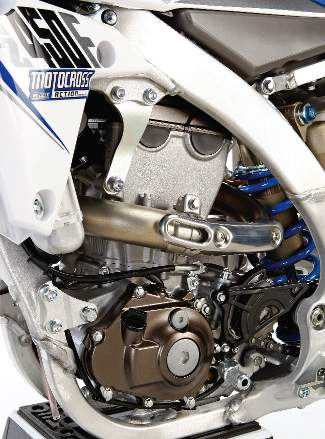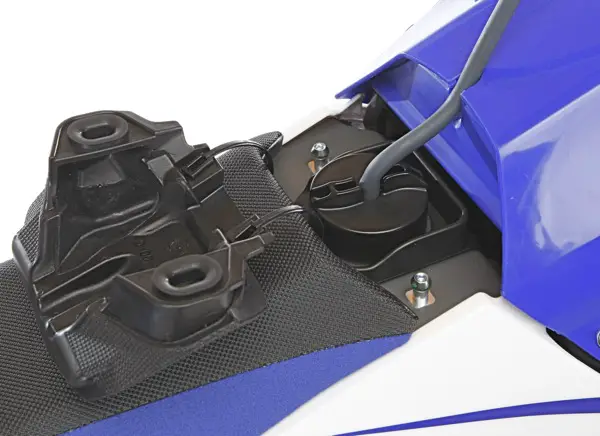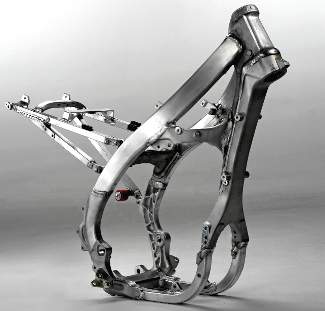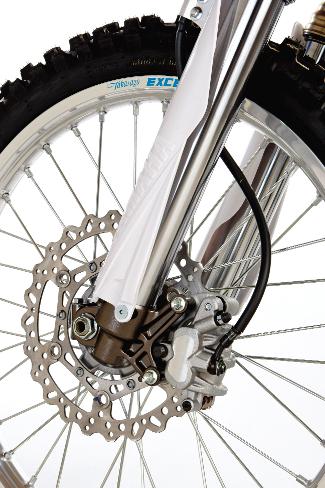WHAT YOU DON’T KNOW: THE SCIENCE BEHIND THE 2014 YAMAHA YZ450F

WHAT’S NEW ON THE 2014 YAMAHA YZ450F?
The best part of the 2014 YZ450F’s redesign is that Yamaha listened to the complaints of local YZ450F racers. Remember the ultra-wide radiator wings? The 2014 wings are 14mm narrower. Remember how DR.D made lowering kits for the YZ450F radiators? The 2014 radiators are lower. Remember how hard it was to get into the airbox? The 2014 airbox does not require the rider to remove the radiator wings, seat and gas tank anymore. Remember how obnoxiously loud the airbox was when riding the YZ450F? The 2014 YZ450F is twice as quiet. Remember the engine relocation kit that every National rider put on his YZ450F to move the engine forward? The 2014 engine is 10mm closer to the front wheel. Whatever your issue was with the previous bike, Yamaha’s engineers tried to do something about it for 2014.

IS THE ENGINE THE SAME AS IN 2013?
No. Every part of the engine has been moved, changed, recast or redesigned. Here is the list:
Intake cam. The intake cam has 0.20mm less lift and a more gradual lobe that opens the valves sooner than in 2013.
Intake valves. The diameter of the intake valves has been increased from 36mm to 37mm, and the valves have new intake port shapes to go with the size increase.
Exhaust valves. The diameter of the exhaust valves has gone from 30mm to 30.5mm, and the valves have new intake port shapes to go with the size increase.
Rev limiter. The upper rev limit has been increased by 250 rpm.
Piston. The compression ratio stays the same at 12.5:1, but the 2014 piston is a flat-top piston instead of domed. Additionally, the piston has a friction-reducing coating on the skirt sides.
Wet sump. Gone is the oil tank in the front of the YZ450F engine. The 2014 engine has been changed to a wet-sump design with an oil mister aimed under the piston.
Water pump. The water pump employs a plastic resin impeller to save weight.
IS YAMAHA’S BACKWARD ENGINE A CRACKPOT IDEA?
No, it isn’t. The Yamaha engineers didn’t come up with this idea out of the blue, and they aren’t doing it just to be different. Way back in 2006, Yamaha tilted the YZ450F cylinder and head back 4 degrees, which moved the weight and rotating mass of the engine about 20mm closer to the bike’s center of gravity. The 4 degrees was almost imperceptible to the human eye, but every rider raved about how much lighter the 2006 bike felt in roll, pitch and yaw (compared to the 2005 model).
Yamaha’s engineers were emboldened by the 2006 experiment and got the R&D budget to start over from scratch. Their goal was to minimize the gyroscopic effects of the engine’s rotating parts.

WHAT IS THE SCIENCE BEHIND THE YZ450F’S UNUSUAL LAYOUT?
Even though many riders don’t like it and can’t understand it, the scientific theory behind Yamaha’s backwards-engine design is solid. Yamaha isn’t tilting the engine rearward just to be different, but to move a significant amount of the bulk and rotating mass of the drivetrain (cams, valves, cam chain and piston) toward the center of the bike. We won’t bore you with classroom lectures on the relationship between reciprocating forces and gyroscopic stability. Suffice it to say that a body in motion, like a crankshaft, rod, piston, camshaft or timing chain, not only wants to stay in motion, but its sphere of influence spreads across the complete machine. Yamaha’s backwards engine moves the reciprocating mass toward the center of gravity in an effort to harness the gyroscopic effects. For example, as the camshafts spin, they develop their own gyroscopic inertia. And, like any gyroscope, they fight against the forces of gravity to maintain their own stability. You can knock a gyroscope around, but it will always return to its vertical axis. Thus, spinning camshafts, rotating cranks, pump-action valves and reciprocating pistons are moving objects that exert their influence on the overall handling package. As you lean the bike to the right, the camshafts are trying to stop the bike from leaning. That is what spinning objects do. And, that is what Yamaha is trying to mitigate.

HOW DOES ROTATING MASS WORK?
Here is a simple way to visualize the rotating mass of a four-stroke engine: Think of a figure skater, like Nancy Kerrigan, doing a spin on ice. As she begins to spin, she has her arms outstretched, but when she wants to spin faster, she moves her arms closer to her body’s center of gravity. By holding her arms against her body, Nancy Kerrigan reduces her rotational inertia. If figure skaters can control the speed of their spins by harnessing rotational inertia, then motocross designers can do the same thing. Yamaha’s engineers wanted to get the gyroscopic forces of the cams, crank and piston closer to the center of gravity so that the spinning parts would have fewer negative effects on pitch (rotation around the side-to-side axis), roll (rotation around the front-to-back axis) and yaw (rotation around the vertical axis).
WHAT ARE THE NUMBERS, DIMENSIONS & SPECS OF THE 2014 YZ450F?
The 2014 Yamaha YZ450F cylinder is slanted rearward 12.7 degrees, which moves the cams 2 inches closer to the center of gravity. Unfortunately, the radical slant of the cylinder meant that the exhaust port had to move to the rear and the intake port to the front. Yamaha never wanted to move the fuel injector to the front and the pipe to the back, but it was a necessary byproduct of their desire to harness the gyroscopic forces. But, the cylinder is the only part of the 2014 YZ450F that has been moved:

Width. The 2014 YZ450F is 14mm narrower at the radiator wings than it was in 2013.
Overall height. The 2014 YZ450F is 22mm lower than the 2013 bike.
Seat height. The 2014 YZ450F seat height is 24mm lower than in 2013.
Wheelbase. The wheelbase is 14mm shorter than on the 2013 bike. This is because Yamaha used the same chain, but went from a 48- to a 49-tooth rear sprocket, which pulled the wheel forward.
Ground clearance. The 2014 YZ450F is 45mm lower than the 2013 bike.
Head angle. The 2014 head angle is 27.08 degrees, while the 2013 model’s head angle was 26.95 degrees.
Steering head. The steering head tube has been moved back 10mm from last year, which changes the front center (the distance from the crank to the front axle) by 10mm. In layman’s terms, this means that the front wheel is moved back 10mm.
Trail. The 2014 YZ450F has 119mm of trail, while the 2013 model had 120mm of trail.
Front axle. The front-axle diameter has been increased from 20mm to 22mm for more rigidity, which means that pre-2014 front wheels will not fit.
Airbox. The 2014 airbox is 256 percent larger than the 2013 airbox, and the over-the-cage air filter has 35 percent more surface area than last year’s toast-shaped filter.
Fuel tank. Fuel capacity has been increased from 1.6 gallons to 2 gallons.
WHAT’S NEW ABOUT THE 2014 GEARBOX?
Stick with us on this, because it gets a little confusing. Yamaha wanted to close the gap between second and third gears. There were two ways to achieve this: They could raise the gear ratio in second gear, or they could lower the gear ratio in third. Yamaha chose the latter and changed third gear from 18/23 to 20/26. Third gear on the 2013 YZ450F had a 1.278 gear ratio; the 2014 model’s third gear has a lower 1.300 ratio.
Perhaps it could be argued that raising second gear would have been a better choice, since most riders don’t use first gear anyway and moving second up would have kept the gaps between third, fourth and fifth the same; however, Yamaha chose to lower third gear, which means that not only is third gear now closer to second gear, it is farther away from fourth. During testing, we noticed that the YZ450F would tend to fall off the pipe on the upshift to fourth.

Making matters worse is that Yamaha changed the primary gear in the 2014 YZ450F gearbox from 23/61 to 23/60. This means that the primary gear ratio went from a lower 2.652 to a taller 2.609, raising the overall gear ratios of every gear. Obviously, this did very little to help the gap between third and fourth. Yamaha’s solution was to add an extra tooth to the rear sprocket (changing last year’s 13/48 to a 13/49), which made the final drive ratio a 3.769 instead of a 3.692.
It helps if you have a scorecard handy, but to recap: Yamaha lowered third gear, raised all the gear ratios via the primary gear, and then lowered all the gears with the rear sprocket. Maybe it is just us, but we tend to think that the extra 3 horsepower in the YZ450F’s midrange would have solved the gap issue between second and third gear without all the cog shuffling.

THE CHOKE KNOB IS NOT WHAT IT SEEMS
The choke knob on the side of the throttle body may look like a choke, but it isn’t. The knob on the side of the throttle body increases the amount of intake air that goes into the engine. You use it when the engine is cold and not when the engine is hot.

WHY ISN’T THE MUFFLER RUBBER-MOUNTED?
The right side of the aluminum subframe is an extreme scalene triangle, with two long sides and one narrow side, but none of them equal. Yamaha had to pinch the shape of the subframe down to make room for the muffler to be moved 188mm (7.3 inches) forward on the chassis. The muffler is solidly mounted to the subframe at the rear and the frame at the mid-pipe. Why isn’t it rubber-mounted? Because the exhaust pipe is structural to the subframe, which means that the pipe itself helps support the rear fender.
WHAT IS THE BEST GEARING COMBINATION?
We wish we knew. Since Yamaha has played tic-tac-toe with the gearbox for 2014, we tried every possible combination from 48 teeth to 51 teeth. For fast tracks with long straights and lots of room, we stuck with the stock 49. It is important to remember that the 2014 YZ450F’s 49-tooth sprocket isn’t the same as putting a 49 on the 2013 YZ-F. Nope, the new 49-tooth sprocket is more like last year’s 48-tooth sprocket (because of the primary gear change). Thus, if you want to gear the 2014 YZ450F lower to make better use of third gear, you will need to go to a 50-tooth sprocket. Most MXA test riders preferred this gear combo for racing. At one point we hypothesized that going even lower, to a 51, would allow us to use third gear more and close the gap to fourth gear, but all it really did was make second gear too low without enabling third gear to replace it.
WHAT WAS OUR BEST MAP?

We had major issues with the fuel and ignition mapping. No surprise! Last year we remapped the YZ450F to eliminate the irritating bark off idle. And since the 2014 YZ450F has the same bark, albeit a little less irritating, our first mapping attempt was a copy of our 2013 “Mellow Map.” This popular 2013 map retarded the ignition and richened the fuel down low. Unfortunately, it didn’t work on the 2014 model?at all. It made the stutter off the bottom worse and killed the power.
Common sense told us that going richer on the fuel and retarding the ignition was the best remedy, but the best-laid plans of mice and men often go astray.
Starting over, we borrowed a map from Yamaha test rider Travis Preston. One look at Preston’s map told us that it couldn’t possibly work. It was super rich and super advanced. How rich? It was 12 percent richer from idle to 3/8 throttle and 9 percent richer on top. Even more shocking was Preston’s ignition map. He had advanced the ignition 3 degrees in the lower quadrants and 2 degrees in the full-throttle and high-rpm quadrants.
We were skeptical, but we tried it, and it worked. Yes, it felt rich, but the power improved across the board, and our major mapping complaints were lessened. Always scofflaws, we started making more maps, encouraged by the ease with which they could be programmed into the YZ450F’s black box. We made so many maps that on some of them, only one number out of nine was different. For some reason, our best map was a variation on Travis Preston’s map, with the exception of two different numbers on the low-end.
Here is the map we ran with the stock exhaust system:

WHAT ABOUT MAPPING FOR AN AFTERMARKET EXHAUST PIPE?
During our testing, the map we used with the stock exhaust system didn’t work with aftermarket pipes. After another round of tests, we discover that aftermarket pipes worked best with the stock ignition timing and slightly richer fuel mapping. Typically 1, 1, 1 on the bottom and second row and 2, 2, 2 on the top row of the fuel map graph. In colder weather you might try 2, 2, 2 on the bottom two rows and 3, 3, 3 on the top row. It should be noted that all of the aftermarket pipes from FMF, DR.D, Pro Circuit or Yoshimura are designed around the stock 0, 0, 0 maps.
WHAT COULD YOU DO TO IMPROVE THE 2014 YZ450F’S HANDLING?

Thankfully, the major stuff that we did from 2010 to 2013 to make the YZ450F handle better, Yamaha did for us in 2014. Most notably, they moved the engine forward 10mm (7mm farther forward than we could with our limited backyard engineering), and they moved the radiators down on the frame (we used a DR.D lowering kit last year and probably will do so again in 2014).
That leaves four things that a YZ450F owner could do to make the YZ450F feel more accurate.
(1) Shock linkage. We swapped out the stock, 142mm, rising-rate linkage for a longer 143.5mm Pro Circuit arm. This lowered the rear of the chassis, which eliminated the stinkbug feel of the 2014 layout. It also gave us more leeway in selecting the head angle best suited to the track we were riding on any given day. With the rear 8mm lower, we could slide the forks up to make the YZ450F turn sharper, but if we felt too much oversteer, we could slide the forks down in the clamps to slacken the head angle. Best of all, the longer link flattened out the chassis and made it feel more balanced. It should be noted that if you drop the rear of the 2014 YZ450F with a longer link, you should compensate by sliding the forks up 2mm and taking two clicks out of the low-speed compression.

(2) Front brake. Why would we talk about brakes in this section when brakes are about stopping, not handling? Because it’s not true. Good brakes allow you to set the chassis into the terrain, initiate dive on the entrance to corners, and they hold the front steady on off-cambers. Brakes do more than stop the bike. Sadly, compared to the KTM’s 260mm Brembo front brakes, the YZ450F barely has any brakes. An aftermarket oversize rotor will not only stop better, but your YZ450F will handle better when you have the excess pucker power to make it do what you want.
(3) Tires. The MXA wrecking crew is always amazed that a manufacturer will spend millions of dollars on engine design and chassis setup, and then throw a mediocre front tire on the bike. Yamaha did spec the latest version of the Dunlop MX51, but the MX51FA is just a workmanlike front tire. Most MXA test riders prefer a Bridgestone 403/404 combo or a Dunlop MX51 rear mated to an MX31 front.
(4) Bar position. When you are in the saddle, the YZ450F feels more like a YZ250F in terms of riding position and roominess. Most test riders liked the stock position, but, for variety’s sake, Yamaha has added triple clamps with front and rear mounting holes that, when combined with the eccentric handlebar mounts, offer four different bar positions. We stayed in the rear holes with the eccentric bar mounts rotated forward, but you might like a different position.
(5) Airbox. The MXA wrecking crew has never been fans of the YZ450F airbox. In fact, last year we said, “The Bank of America should take a close look at the YZ450F airbox design before they build any more vaults. Nobody can crack into this thing without a stick of dynamite. Having to remove the seat, six bolts and flip the gas tank up to change a filter seems like overkill.”
So, for 2014, Yamaha did something about it. They moved the gas tank back, aided by the fact that they had gotten rid of the convoluted Tornado exhaust system. In fact, they moved the tank so far back that there was no room for a gas cap. Borrowing a page from Husqvarna, they put the gas cap in the seat, or, more accurately, under a flip-top flap in the front of the seat. By moving the gas tank rearward, they doubled the room for the airbox and the air filter. Now, to get to the air filter, all you have to do is remove three 8mm hex heads.






Comments are closed.